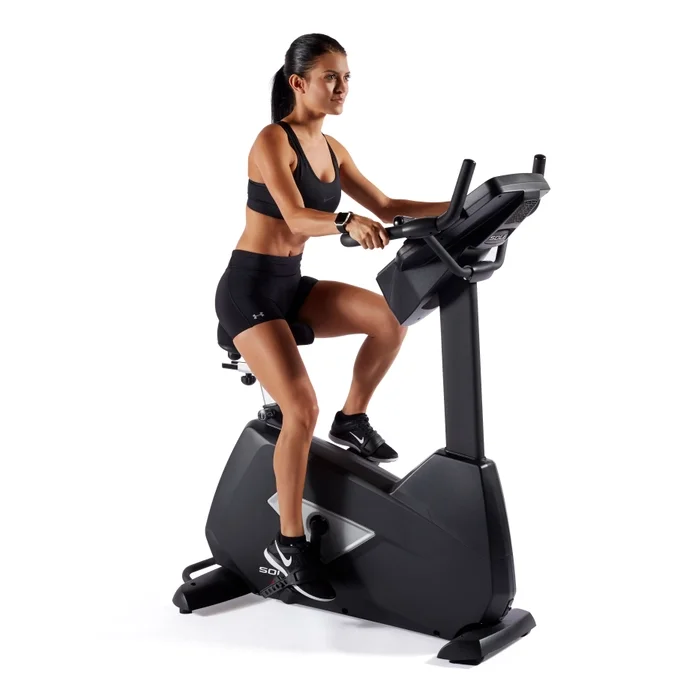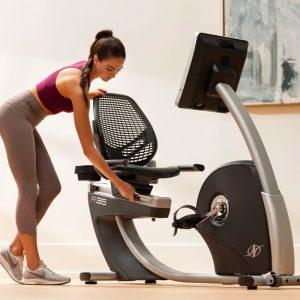As you go about your search for an exercise bike, you might come to wonder, which type of exercise should you be using? You may see the words magnetic and flywheel being tossed around. So in the question, which is better, exercise bike magnetic vs. flywheel, you feel a bit confused.
In order to answer this question, you need to remember one important thing: it is not a versus situation here.
Almost all exercise bikes come with a flywheel of sorts. It’s how the flywheel is used that you need to be looking at.
In many cases, the weight of the flywheel is what’s the variable factor. The heavier the flywheel, the harder it’s going to be to pedal and thus the greater the resistance will be. This does become a limiting factor however because as your flywheel gets heavier and heavier, the bike is also going to get bigger and bigger. Since we don’t want gigantic bikes sitting in our homes, we need to find another way. Two of the popular methods are direct contact resistance on the flywheel or else magnetic resistance.
Once you’ve read this article, you can check out our The 9 Best Exercise Bikes of 2025 where our fitness editor, Brian Boyce (CPT) has reviewed the best bikes per category and has made his expert recommendations on which bike to look to get.
Let’s look at these two more closely so that you can determine which is the right model for you.
| Magnetic Resistance | Direct Contact Flywheel | |
| Can increase and decrease resistance easily | Yes | Yes |
| Accurate level of resistance | Yes | Yes |
| High Levels Of Resistance Achieved | Yes | Yes |
| Level of Wear And Tear | Low | High |
| Noise | Low | High |
| Maintenance | Low | High |
| Price | High | Lower |
Let’s look at these more closely now.
Changing The Level Of Resistance
 The first question you are probably asking yourself is if it’s possible to change the level of resistance quite easily. The good news is that in the exercise bike magnetic vs. flywheel resistance, this can be achieved quite easily.
The first question you are probably asking yourself is if it’s possible to change the level of resistance quite easily. The good news is that in the exercise bike magnetic vs. flywheel resistance, this can be achieved quite easily.
With magnetic resistance it’s just a matter of having gears that are used on the bike to adjust how the magnets are interacting with the flywheel and with direct contact flywheel set ups, it’s about the contact pads moving closer, creating more friction.
Provided the bike is in proper working order, both should be able to achieve great results.
Accurate Levels Of Resistance
The next question you have to ask yourself is whether you can achieve accurate levels of resistance with both bikes. If you are trying to advance your program, it’ll be important that you are always biking at the same level of resistance as you did the last session – or even higher.
So is this possible?
To a degree, yes. The magnetic flywheel system is more accurate as these are typically computerized, and you will just punch in which level you want to be at. It’s the type that you see so often in the commercial gyms because these bikes are very popular.
So if you want accuracy, this may be the one to go with.
With the contact-based resistance model flywheel, it can be slightly less accurate, but it’s generally still quite good. Most people should easily be able to complete their workout fine and see good advancements using this type of resistance, so it’s not something that you really need to be worrying about.
To boil it down, magnetic exercise bikes’ resistance levels are preset, and riders can see what level they are riding at via the console. Flywheel resistance systems are more flexible. Riders just adjust using the knob without knowing what exact level they are at.
If you are someone who’s say training for a road race, and you need utmost precision, then the magnetic flywheel will take the edge.
High Levels Of Resistance Achieved
 When considering exercise bike flywheel versus magnetic resistance models, you also may want to ask yourself how high of resistance can you get with both of these models. Obviously getting to the highest overall level of resistance will be critical to ensuring that you are doing great things.
When considering exercise bike flywheel versus magnetic resistance models, you also may want to ask yourself how high of resistance can you get with both of these models. Obviously getting to the highest overall level of resistance will be critical to ensuring that you are doing great things.
If you hope to get stronger, burn more calories, and get faster with your cycling, adding more resistance is all part of that game.
The good news here is that both of these are able to get you to very high levels of resistance. With magnetic resistance, you can apply it so high that the wheel essentially stops running altogether. Contact-based resistance systems have higher resistance as the rider can keep adding resistance until the pedals can’t continue, whereas magnetic bikes have a fixed resistance level range.
Level Of Wear And Tear
Which bike is going to have more wear and tear? For this, most definitely contact forms of resistance. Magnetic resistance is nearly completely maintenance free because the only thing that’s changing is how powerful the magnet is that’s being utilized to prevent the spinning of the flywheel.
With contact-based resistance, something is actually touching that flywheel, so you are going to get that higher level of wear and tear on those pads, which may then eventually have to be replaced.
So if you don’t want to spend any money in replacement costs, go with a magnetic bike. Your chances of ever needing to replace anything are far lower.
Noise
If you plan to use this bike at home in the early hours in the morning or late at night, noise is probably going to be something that you want to be considering. The last thing that you want is a bike that’s so noisy you can hear it three rooms away.
If this is the case, you definitely want to go with a magnetic system. Contact based resistance models are much louder because something is actually touching that flywheel, slowing it down. This creates friction and as such, noise.
Ease in Transport
Do you anticipate moving your exercise bike around a lot? Maybe you’re concerned with getting a heavy piece of equipment unloaded and assembled. While each individual product will have a unique weight, generally speaking, flywheel-based resistance bikes are heavier than magnetic ones and harder to transport or move around your home.
Price
Lastly, consider price. If budget is your primary concern, you’ll find that contact-based resistance flywheel systems are cheaper than their magnetic resistance counterparts.
Magnetic resistance bikes typically do come with all the bells and whistles though – programmable options, the LED console screen, and such, so you are getting an overall better experience on these bikes – or at least what some people would consider to be.
But if you want more of a traditional feel like you are just riding a regular bike outside, then you will probably love the contact-based resistance bikes and can get one at a lower price point.
So keep these pros and cons in mind when you choose which type of bike you want to purchase. Both bikes are going to offer great results and can certainly take your fitness up a notch, but you do need to consider which one is going to be most suited to your goals, needs, and preferences.
Best Magnetic Resistance Exercise Bikes
NordicTrack X24 Bike
The X24 is NordicTrack’s response to the Peloton revolution. It allows you to bring the energizing atmosphere of a studio spin bike class home. For my hands-on review of this bike, read here.
Sole LCB Upright Bike
The Sole LCB Light Commercial Bike is a great basic for shared workout spaces and adds a bit of luxury to home gyms. To read our review of this bike, read here.






